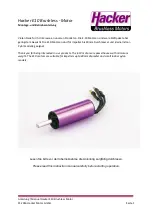
4. Determine the Input Watts per Pound required to achieve the desired level of performance:
Model: Hangar 9 P-51 Miss America
Estimated Flying Weight w/Battery: 9.0 lbs
Desired Level of Performance: 90-110 (100 average) watts per pound; Fast flying scale model
9.0 lbs x 100 watts per pound = 900 Input Watts of total power (minimum)
required to achieve the desired performance
5. Determine a suitable motor based on the model’s power requirements. The tips below can help you determine the power capabilities
of a particular motor and if it can provide the power your model requires for the desired level of performance:
•
Most manufacturers will rate their motors for a range of cell counts, continuous current and maximum burst current.
•
In most cases, the input power a motor is capable of handling can be determined by:
Average Voltage (depending on cell count) x Continuous Current = Continuous Input Watts
Average Voltage (depending on cell count) x Max Burst Current = Burst Input Watts
HINT: The typical average voltage under load of a Ni-Cd/Ni-MH cell is 1.0 volt. The typical average voltage under load of a Li-Po cell is
3.3 volts. This means the typical average voltage under load of a 10 cell Ni-MH pack is approximately 10 volts and a 3 cell Li-Po pack
is approximately 9.9 volts. Due to variations in the performance of a given battery, the average voltage under load may be higher or
lower. These however are good starting points for initial calculations.
Model: Hangar 9 Miss America
Estimated Flying Weight w/Battery: 9.0 lbs
Input Watts Per Pound Required for Desired Performance: 900 (minimum)
Motor: Power 60
Max Continuous Current: 40A*
Max Burst Current: 60A*
Max Cells (Li-Po): 5-7
6 Cells, Continuous Power Capability: 19.8 Volts (6 x 3.3) x 40 Amps = 792 Watts
6 Cells, Max Burst Power Capability: 19.8 Volts (6 x 3.3) x 60 Amps = 1188 Watts
Per this example, the Power 60 motor (when using a 6S Li-Po pack) can handle up to 1188 watts of input power, readily capable of
powering the P-51 Miss America with the desired level of performance (requiring 900 watts minimum). You must however be sure that
the battery chosen for power can adequately supply the current requirements of the system for the required performance. You must
also use proper throttle management and provide adequate cooling for the motor, ESC and battery.
Battery Choices:
We recommend Thunder Power Li-Po batteries for the best performance and lowest weight (in some cases Ni-MH 1950-3700mAh
high-discharge packs also make good alternatives at the expense of weight and lower capacity). Some examples of the packs we
recommend for use with the Power 60 motor can be found below (In some cases 2 packs are required to be run in series to achieve the
proper operating voltage):
THP42003S2PPL
4200mAh 3S2P 11.1V Li-Po,13GA
THP60003S3PPL
6000mAh 3S3P 11.1V Li-Po,13GA
THP60004S3PPL
4000mAh 4S3P 14.8V Li-Po,13GA
THP53005S4PPL
5300mAh 5S4P 18.5V Li-Po,13GA
Examples of Airplane Setups:
Please see our web site for the most up-to-date information and airplane setup examples.
NOTE: All data measured at full throttle. Actual performance may vary depending on battery and flight conditions.
Hangar 9 P-51 Miss America (HAN2775)
Motor: Power 60
ESC: Castle Creations Phoenix 80 (Standard settings with 18V Soft Li-Po cut off and no brake)
Prop: APC 15x10E
Battery: Thunder Power PRO LITE 6000mAh 6S3P (THP60003S3PPL x2 in series)
Flying Weight w/Battery: 8.8 lbs
Amps
Volts
Watts
Input
Watts/Pound
RPM
56.0
21.3
1195
136
7375
Expect very strong performance with a great balance of thrust and top speed. Average duration is approximately 8-15 minutes
depending on throttle management.






















